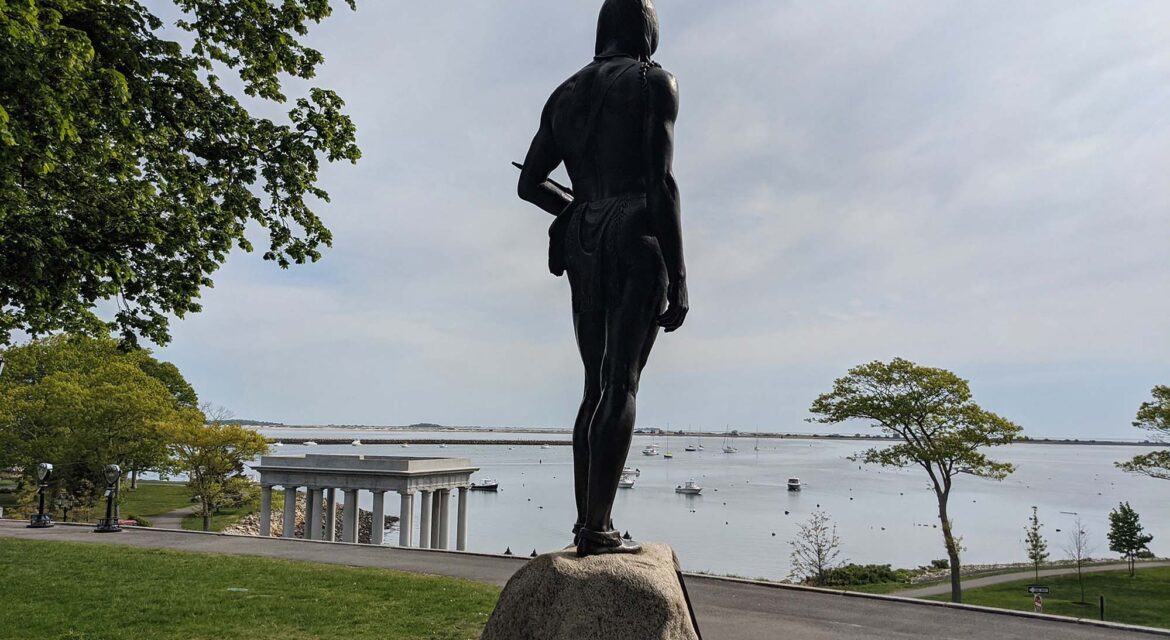 While Plymouth Rock is the most notable attraction in Pilgrim Memorial State Park, the space contains various other landmarks and features that have allowed it to cultivate a variety of experiences for audiences in Plymouth, Massachusetts. This collection of attractions has enabled visitors to experience the multi-faceted legacy of the Pilgrims in terms of the history, legend and people that have come to define it.
While Plymouth Rock is the most notable attraction in Pilgrim Memorial State Park, the space contains various other landmarks and features that have allowed it to cultivate a variety of experiences for audiences in Plymouth, Massachusetts. This collection of attractions has enabled visitors to experience the multi-faceted legacy of the Pilgrims in terms of the history, legend and people that have come to define it.

Built Around Plymouth Rock
 Created in 1920 to celebrate the 300th anniversary of the Pilgrim landing, Pilgrim Memorial State Park includes a six-acre coastal area on Plymouth Harbor and another eleven-acre inland park in the center of town. The legendary Plymouth Rock is the main and preexisting attraction in the space, with everything else being literally built around it.
Created in 1920 to celebrate the 300th anniversary of the Pilgrim landing, Pilgrim Memorial State Park includes a six-acre coastal area on Plymouth Harbor and another eleven-acre inland park in the center of town. The legendary Plymouth Rock is the main and preexisting attraction in the space, with everything else being literally built around it.
Across the street from Plymouth Rock is a stairway that leads to the top of Cole’s Hill, providing an incredible panoramic view of the area. This Pilgrim Sarcophagus is at the top of this hill, which contains the remains of many early Pilgrims and is where a number of organizations have memorialized their connections to the Pilgrims.
Near the Sarcophagus is a statue of Massasoit, the Great Sachem of the Wampanoags who was a protector of the Pilgrims. Erected as a grateful tribute, a nearby marker mentions the National Day of Mourning on Thanksgiving to honor Native ancestors and the struggles of Native people to survive in the present. This reality is juxtaposed with the experiences that visitors can have on the Mayflower II, which sits in the water very near Plymouth Rock. It allows visitors to experience a reproduction of the ship that transported the Pilgrims.
Other nearby monuments include the “Pilgrim Mother” fountain and garden by Paul O. Jennwein, which was erected in 1920 by the Daughters of the American Revolution, as well as the William Bradford Statue. The National Monument to the Forefathers resides further inland but has come to serve as an important part of the park.
Audiences can connect with these pieces in specific ways and at their own pace, highlighting how such experiences don’t need to be confined and can enable numerous opportunities for stakeholders and entire communities.

Connections that Drive the Culture and Economy of Plymouth
 Educational programs are available in the park throughout the year while 10-minute historical talks are given on a frequent basis at Plymouth Rock. The park is also close to the Pilgrim Trail, which is a 1.8 mile trail. It is primarily used for hiking, walking, and nature trips.
Educational programs are available in the park throughout the year while 10-minute historical talks are given on a frequent basis at Plymouth Rock. The park is also close to the Pilgrim Trail, which is a 1.8 mile trail. It is primarily used for hiking, walking, and nature trips.
The Pilgrim Path Audio Tour is a self guided audio tour that highlights 28 of Plymouth’s most historic sites. It allows audiences to experience the sites and area in multiple ways.
These experiences are in addition to what audiences can see for themselves via the panoramic view from the top of Cole’s Hill or the products they can purchase at any of the numerous shops and stores located throughout the area. All of them sell items that are unique to Plymouth and exist on account of the activity that Pilgrim Memorial State Park has helped to generate.
Plymouth Rock was listed in the National Register in 1970 and the National Monument to the Forefathers was listed in 1974, highlighting how individual monuments can further compel interest in places like Pilgrim Memorial State Park and even enable their creation. It highlights what it can mean to cultivate audience connection that is about more than a single monument or landmark.

Experiencing the Multi-faceted Legacy of an Entire Country
 Drawing more than 1 million visitors each year, Pilgrim Memorial State Park is the smallest park in the Massachusetts state forest and park system but is also the most heavily visited. What could have been an isolated experience with Plymouth Rock has instead become a place where visitors in the present and future can experience the legacy of the Pilgrims.
Drawing more than 1 million visitors each year, Pilgrim Memorial State Park is the smallest park in the Massachusetts state forest and park system but is also the most heavily visited. What could have been an isolated experience with Plymouth Rock has instead become a place where visitors in the present and future can experience the legacy of the Pilgrims.

